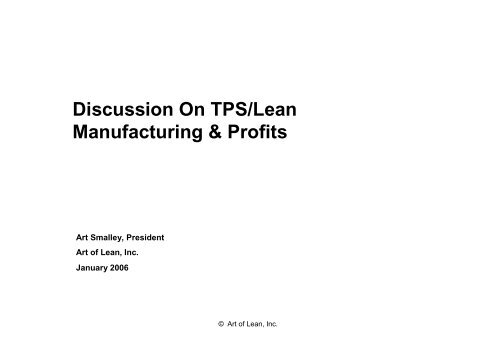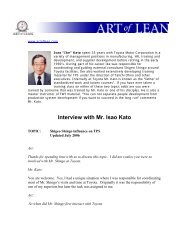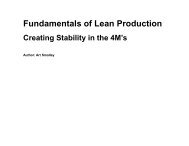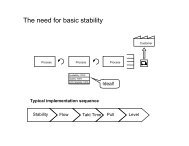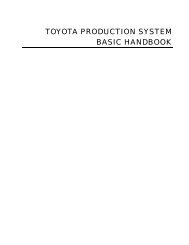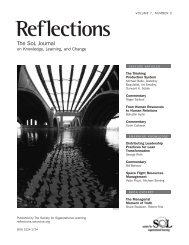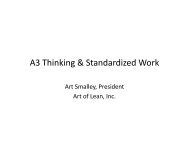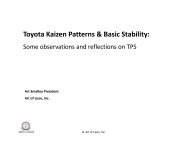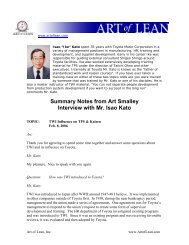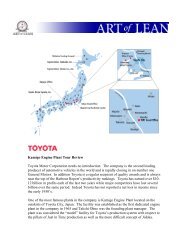Discussion On TPS/Lean Manufacturing & Profits - Art of Lean
Discussion On TPS/Lean Manufacturing & Profits - Art of Lean
Discussion On TPS/Lean Manufacturing & Profits - Art of Lean
You also want an ePaper? Increase the reach of your titles
YUMPU automatically turns print PDFs into web optimized ePapers that Google loves.
<strong>Discussion</strong> <strong>On</strong> <strong>TPS</strong>/<strong>Lean</strong><br />
<strong>Manufacturing</strong> & <strong>Pr<strong>of</strong>its</strong><br />
<strong>Art</strong> Smalley, President<br />
<strong>Art</strong> <strong>of</strong> <strong>Lean</strong>, Inc.<br />
January 2006<br />
© <strong>Art</strong> <strong>of</strong> <strong>Lean</strong>, Inc.
<strong>TPS</strong>/<strong>Lean</strong> is a widely accepted improvement program<br />
• Starting from simple roots in Toyota in the 1950’s <strong>TPS</strong> has<br />
spread around the world to become a dominant improvement<br />
methodology<br />
• Toyota will overtake GM in 2006 or 2007 as the automotive<br />
industry leader in volume and add this to their already<br />
dominant positions in quality and pr<strong>of</strong>itability<br />
• <strong>TPS</strong> has been “discovered” by multiple people over the years<br />
and identified as various different items such as:<br />
– QC circles<br />
– Kanban system<br />
– Kaizen events<br />
– Value stream mapping<br />
– What’s next<br />
• Yet, no one has been able to copy this elusive system very<br />
easily and produce the same type <strong>of</strong> results…Why<br />
Copyright © 2005 <strong>Art</strong> <strong>of</strong> <strong>Lean</strong>, Inc.<br />
© <strong>Art</strong> <strong>of</strong> <strong>Lean</strong>, Inc.
Multiple possible explanations exist…<br />
• Toyota took about 20 years or so between 1950-1970 to build<br />
up the system and implement it across several plants. Most<br />
practitioners are in about year five or less…<br />
• A short term emphasis in our U.S. business model keeps us<br />
overly focused on quarterly pr<strong>of</strong>its…<br />
• There is a shortage <strong>of</strong> talented <strong>TPS</strong> implementation<br />
leaders…Most <strong>of</strong> us don’t have Taiichi Ohno for example.<br />
• Perhaps creating this new system in companies with an<br />
established culture and old way <strong>of</strong> doing things is just<br />
inherently very difficult…<br />
• The methods and techniques most companies are using are<br />
either just insufficient or incorrect…<br />
• Other possible reasons that you might add<br />
Copyright © 2005 <strong>Art</strong> <strong>of</strong> <strong>Lean</strong>, Inc.<br />
© <strong>Art</strong> <strong>of</strong> <strong>Lean</strong>, Inc.
<strong>TPS</strong> is viewed is the U.S. through a very “lean” lens…<br />
LTS Q’s - Map the value stream<br />
1. What is takt time<br />
2. Where can you use continuous<br />
flow<br />
3. What is the pacemaker<br />
4. Where will you need a<br />
supermarket pull system<br />
5. Will you build to a finished<br />
goods supermarket or to<br />
customer order<br />
6. How will you level production<br />
mix at the pacemaker<br />
7. What increment <strong>of</strong> work will you<br />
consistently release and take<br />
away at the pacemaker<br />
8. What process improvements will<br />
be necessary for the value<br />
stream to flow as your future<br />
state design specifies<br />
Copyright © 2005 <strong>Art</strong> <strong>of</strong> <strong>Lean</strong>, Inc.<br />
© <strong>Art</strong> <strong>of</strong> <strong>Lean</strong>, Inc.
A lens affects how well and what you see…<br />
Eye Glasses Microscope Telescope<br />
Blurred image<br />
Small image<br />
Distance image<br />
Clear image<br />
Magnified image<br />
Closer image<br />
But one size does not fit all in any case!<br />
Copyright © 2005 <strong>Art</strong> <strong>of</strong> <strong>Lean</strong>, Inc.<br />
© <strong>Art</strong> <strong>of</strong> <strong>Lean</strong>, Inc.
Major paradigm shift from Mass to <strong>Lean</strong><br />
Mass Production<br />
• Economy <strong>of</strong> scale<br />
• Dedicated machines<br />
• Dedicated job<br />
classifications<br />
• Few changeovers /<br />
large batch<br />
• Improvements by new<br />
manufacturing<br />
technology<br />
• Improvements by<br />
engineers &<br />
management<br />
• Inspect in quality<br />
• Always run machines<br />
• High inventory<br />
• Apparent efficiency is<br />
king<br />
Copyright © 2005 <strong>Art</strong> <strong>of</strong> <strong>Lean</strong>, Inc.<br />
© <strong>Art</strong> <strong>of</strong> <strong>Lean</strong>, Inc.<br />
<strong>Lean</strong> Production<br />
• Economy <strong>of</strong> scope, speed<br />
• Flexible systems<br />
• Cross trained multifunctional<br />
workers<br />
• Frequent changeover / small<br />
batch<br />
• Improve the method first,<br />
then technology next only as<br />
a second step<br />
• Improvements by work<br />
teams, supervisors,<br />
engineer, & management<br />
• Build in quality<br />
• Run only on demand<br />
• Low inventory<br />
• True efficiency is key
Minor paradigm shift on how to conduct lean<br />
<strong>TPS</strong><br />
Whatever you<br />
decide to call it, it is<br />
a big system guys!<br />
1980’s<br />
It’s tools!<br />
2000<br />
It’s a Value Stream!<br />
1990’s<br />
It’s Kaizen!<br />
Copyright © 2005 <strong>Art</strong> <strong>of</strong> <strong>Lean</strong>, Inc.<br />
© <strong>Art</strong> <strong>of</strong> <strong>Lean</strong>, Inc.
<strong>TPS</strong> actual history: Timeline – Selected Events<br />
1937 Start <strong>of</strong> Toyota Motor Company<br />
1945 End <strong>of</strong> 2 nd world war<br />
1950 Trips to America to visit Ford / Supermarkets observation / <strong>TPS</strong> start<br />
1951 Initial supervisor training using TWI material<br />
1955 Emergence <strong>of</strong> more “efficient production system” (Machining plant<br />
with flow, multi-process handling, visual control, standardized work,<br />
basic pull)<br />
1961 TQC efforts begin (driven by Eiji Toyota)<br />
1962 Synchronization <strong>of</strong> plants and full kanban adoption across company<br />
1965 Toyota awarded Deming prize for quality<br />
1969 Toyota establishes OMCD / <strong>TPS</strong> codification strengthens<br />
1971 Toyota related plants awarded TPM award<br />
1972 Regular supplier improvement workshops commence<br />
1973 <strong>TPS</strong> basic format complete and initial handbooks drafted*<br />
1984 First major <strong>TPS</strong> launch overseas (NUMMI in US)<br />
1990 Introduction <strong>of</strong> <strong>TPS</strong> (i.e. lean production) to outside world by J.<br />
Womack and D. Jones<br />
*VSM is not listed in any Toyota handbook as a major <strong>TPS</strong> tool. The tool is<br />
mainly used by a few select individuals working with suppliers and on line<br />
conversion work to emphasize material, motion, and information flow. It<br />
focuses by design on a subset <strong>of</strong> <strong>TPS</strong> and not the whole…<br />
Copyright © 2005 <strong>Art</strong> <strong>of</strong> <strong>Lean</strong>, Inc.<br />
© <strong>Art</strong> <strong>of</strong> <strong>Lean</strong>, Inc.
<strong>TPS</strong> Framework<br />
LTS* - Map the value stream<br />
1. Takt time<br />
2. Continuous flow<br />
3. Pacemaker<br />
4. Supermarket pull system<br />
5. MTO/MTS<br />
6. Level production<br />
7. Pitch increment<br />
8. Process improvements for flow<br />
Quality<br />
Just-in-time<br />
-Flow production<br />
-Takt time<br />
-Pull system<br />
-Level production<br />
Customer satisfaction<br />
& Company pr<strong>of</strong>it<br />
Cost<br />
Lead time<br />
Jidoka<br />
However, most <strong>of</strong> the<br />
<strong>Lean</strong> focus in the U.S.<br />
today is on just a part<br />
<strong>of</strong> overall <strong>TPS</strong><br />
Standardized Work & Kaizen<br />
Equipment Stability<br />
*LTS - Learning to See, followed by CCF - Creating Continuous Flow, MMF - Making Materials Flow, & CLP – Creating Level Pull<br />
Copyright © 2005 <strong>Art</strong> <strong>of</strong> <strong>Lean</strong>, Inc.<br />
© <strong>Art</strong> <strong>of</strong> <strong>Lean</strong>, Inc.
<strong>TPS</strong> Framework – 3 Starting Perspectives<br />
Quality<br />
Customer satisfaction<br />
& Company pr<strong>of</strong>it<br />
Cost<br />
Lead time<br />
<strong>TPS</strong> starting point:<br />
How will you a) achieve customer satisfaction b) obtain a pr<strong>of</strong>it<br />
and c) develop people<br />
If you solve real business problems related to these three areas<br />
you’ll be fine…if you just implement tools you’ll probably struggle.<br />
Copyright © 2005 <strong>Art</strong> <strong>of</strong> <strong>Lean</strong>, Inc.<br />
© <strong>Art</strong> <strong>of</strong> <strong>Lean</strong>, Inc.
<strong>TPS</strong> Framework – Customer Satisfaction<br />
Quality<br />
Customer satisfaction<br />
& Company pr<strong>of</strong>it<br />
Cost<br />
Lead time<br />
<strong>TPS</strong> starting point:<br />
How will you a) achieve customer satisfaction b) obtain a pr<strong>of</strong>it<br />
and c) develop people<br />
1) Produce the highest possible Quality<br />
2) At the lowest possible Cost<br />
3) With the shortest possible Delivery lead-time<br />
Note: More on this later<br />
Copyright © 2005 <strong>Art</strong> <strong>of</strong> <strong>Lean</strong>, Inc.<br />
© <strong>Art</strong> <strong>of</strong> <strong>Lean</strong>, Inc.
<strong>TPS</strong> Framework – Pr<strong>of</strong>it Principle<br />
Quality<br />
Customer satisfaction<br />
& Company pr<strong>of</strong>it<br />
Cost<br />
Lead time<br />
<strong>TPS</strong> starting point:<br />
How will you a) achieve customer satisfaction b) obtain a pr<strong>of</strong>it<br />
and c) develop people<br />
Price/<br />
Cost<br />
Company Circumstances<br />
Price<br />
Pr<strong>of</strong>it<br />
Cost<br />
Time<br />
(Price – Cost) x Volume = Pr<strong>of</strong>it<br />
Three options:<br />
1) Increase price<br />
2) Increase volume<br />
3) Reduce cost<br />
Copyright © 2005 <strong>Art</strong> <strong>of</strong> <strong>Lean</strong>, Inc.<br />
© <strong>Art</strong> <strong>of</strong> <strong>Lean</strong>, Inc.<br />
<strong>TPS</strong> primary<br />
focus is here by<br />
necessity
<strong>TPS</strong> Framework – Cost Reduction Principle<br />
Quality<br />
Customer satisfaction<br />
& Company pr<strong>of</strong>it<br />
Cost<br />
Lead time<br />
$$<br />
Other<br />
Ind.<br />
Labor<br />
S/V<br />
O/H<br />
Mat’l.<br />
1) The way you manufacture<br />
affects cost…<br />
2) The way you design affects cost…<br />
3) As does the way you purchase<br />
material and work with suppliers<br />
4) People and process improvement<br />
are key to making this work<br />
Revenue Cost Pr<strong>of</strong>it<br />
<strong>TPS</strong> (Toyota Way) recognizes<br />
these points and works<br />
equally on all dimensions!<br />
Copyright © 2005 <strong>Art</strong> <strong>of</strong> <strong>Lean</strong>, Inc.<br />
© <strong>Art</strong> <strong>of</strong> <strong>Lean</strong>, Inc.
The way you manufacture affects cost…<br />
Key <strong>TPS</strong> Questions<br />
3. How will you<br />
achieve JIT<br />
Typical Problems<br />
•<strong>On</strong>-time delivery<br />
•Inventory<br />
•Lead-time<br />
Countermeasures<br />
or analysis tools<br />
•VS Mapping<br />
•SMED<br />
•Pull system / kanban<br />
1. How will you<br />
satisfy the<br />
customer and<br />
obtain a pr<strong>of</strong>it<br />
2. What are<br />
your main<br />
problems in<br />
production<br />
4. How will you<br />
build in quality<br />
5. How will you<br />
stabilize<br />
processes<br />
6. How will you<br />
standardized<br />
work<br />
•Customer defects<br />
•Scrap<br />
•Rework<br />
•Downtime<br />
•Capital productivity<br />
•Scrap & Rework<br />
•Labor productivity<br />
•Scrap & rework<br />
•Safety<br />
•Abnormality detection<br />
•Stop the machine<br />
•Address & Solve<br />
•6 losses / OEE<br />
•SMED<br />
•Problem solving<br />
•Job Instruction<br />
•Standardized work<br />
•Motion analysis<br />
7. How will you<br />
develop natural<br />
work team leaders<br />
•Team morale<br />
•Skills development<br />
•Small improvements<br />
•TWI/JR<br />
•TWI/JI<br />
•TWI/JM<br />
8. How will you<br />
sustain and<br />
improve<br />
•Recurring problems<br />
•Firefighting<br />
•Poor problem solving<br />
•PDCA<br />
•Root cause analysis<br />
•Recurrence prevention<br />
Copyright © 2005 <strong>Art</strong> <strong>of</strong> <strong>Lean</strong>, Inc.<br />
© <strong>Art</strong> <strong>of</strong> <strong>Lean</strong>, Inc.
The way you develop products affects cost…<br />
Key <strong>TPS</strong> Questions<br />
1. How will you identify and create key features they customer will desire<br />
2. How will you minimize total cost in design and development<br />
3. How will you produce with a shorter development lead-time<br />
4. How will you stabilize the product development process<br />
5. How will you standardized designs and still maintain critical features<br />
6. How will you build in quality into the design<br />
7. How will you develop critical skills in this department<br />
8. How will you identify problems, solve them and improve over time<br />
Key Point:<br />
The questions are similar to <strong>TPS</strong><br />
questions in manufacturing but<br />
<strong>of</strong> course the focus does need to<br />
change as do the tools…<br />
Market research<br />
Design in concept<br />
VA/VE/VI<br />
Concurrent engineering<br />
CAD/CAM development<br />
Rapid prototyping<br />
Tooling development<br />
Materials research<br />
Others…<br />
Copyright © 2005 <strong>Art</strong> <strong>of</strong> <strong>Lean</strong>, Inc.<br />
© <strong>Art</strong> <strong>of</strong> <strong>Lean</strong>, Inc.
The way you procure materials affects cost…<br />
Key <strong>TPS</strong> Questions<br />
1. How will you identify suppliers and create good working relationships<br />
2. How will you minimize total cost (not piece cost) in procurement<br />
3. How will you procure with a short lead-time<br />
4. How will you stabilize the procurement process<br />
5. How will you standardized the procurement process<br />
6. How will you measure quality, cost, delivery <strong>of</strong> the supplier<br />
7. How will you develop critical skills in this department<br />
8. How will you identify problems solve them and improve over time<br />
Key Point:<br />
The questions are similar to <strong>TPS</strong><br />
in manufacturing but <strong>of</strong> course<br />
the focus does need to change<br />
as do the tools…<br />
Target costing models<br />
Long-term agreements<br />
Supplier development center<br />
Annual cost down targets<br />
VE/VA workshops<br />
Supplier scorecards<br />
Joint development activities<br />
Exchange <strong>of</strong> personnel<br />
Copyright © 2005 <strong>Art</strong> <strong>of</strong> <strong>Lean</strong>, Inc.<br />
© <strong>Art</strong> <strong>of</strong> <strong>Lean</strong>, Inc.
<strong>TPS</strong> Framework – 3 Starting Perspectives<br />
Quality<br />
Customer satisfaction<br />
& Company pr<strong>of</strong>it<br />
Cost<br />
Lead time<br />
<strong>TPS</strong> starting point:<br />
How will you a) achieve customer satisfaction b) obtain a pr<strong>of</strong>it<br />
and c) develop people<br />
If you solve real business problems related to these three areas<br />
you’ll be fine…if you just implement tools you’ll probably struggle.<br />
Copyright © 2005 <strong>Art</strong> <strong>of</strong> <strong>Lean</strong>, Inc.<br />
© <strong>Art</strong> <strong>of</strong> <strong>Lean</strong>, Inc.
<strong>Lean</strong> Implementation: Some Lessons Learned<br />
Techniques System Thinking<br />
•Cherry-picking the tools<br />
is not enough<br />
•The tools comprise a system<br />
•A way <strong>of</strong> thinking underlies the<br />
tools and system<br />
•This “way” <strong>of</strong> thinking and acting<br />
must be transmitted to people<br />
cartoon copyright © U <strong>of</strong> M<br />
Learn the thinking through doing!<br />
Copyright © 2005 <strong>Art</strong> <strong>of</strong> <strong>Lean</strong>, Inc.<br />
© <strong>Art</strong> <strong>of</strong> <strong>Lean</strong>, Inc.<br />
© TWI Network, Inc.
From “LEAN” to “LEARN”<br />
• Arguably what Toyota accomplished in its early days that has<br />
enabled it to continue to thrive is simply that it “learned to learn”<br />
better than anyone else.<br />
• The true “DNA” <strong>of</strong> Toyota is NOT the tools that we see with our<br />
eyes but the underlying principles and paradigms that shape and<br />
drive management thinking<br />
Copyright © 2005 <strong>Art</strong> <strong>of</strong> <strong>Lean</strong>, Inc.<br />
© <strong>Art</strong> <strong>of</strong> <strong>Lean</strong>, Inc.<br />
© TWI Network, Inc.
<strong>Lean</strong> Learning<br />
What do we know about how people learn<br />
People learn:<br />
• Through experience<br />
• Through mistakes<br />
• Through trail and error<br />
Build structured opportunities for people to learn the way they learn<br />
most naturally.<br />
Copyright © 2005 <strong>Art</strong> <strong>of</strong> <strong>Lean</strong>, Inc.<br />
© <strong>Art</strong> <strong>of</strong> <strong>Lean</strong>, Inc.<br />
© TWI Network, Inc.
Summary Points<br />
• Don’t dogmatically follow any set <strong>of</strong> answers or prescriptive<br />
approaches (including my workbook, John Shook’s or anything from<br />
LEI). The T in <strong>TPS</strong> stands more correctly for “Thinking” and not<br />
“Template”. You can’t just copy what <strong>TPS</strong> is or any <strong>of</strong> the tools<br />
are…your business is sometimes quite different.<br />
• Start with the three basic points <strong>of</strong> a) How will we improve customer<br />
satisfaction, b) How will we improve pr<strong>of</strong>its, and c) How will we<br />
develop people As a starter go back to my suggested sets <strong>of</strong><br />
questions - I guarantee you’ll go farther and cover more ground in the<br />
long run.<br />
• If something seems “too hard” or “illogical” then it probably is. Always<br />
question the assumptions and reasons why are doing something…but<br />
<strong>of</strong> course don’t let this stop you from learning by doing.<br />
• Never put the solution or tool in front <strong>of</strong> the problem…follow the<br />
scientific method and you’ll come out better in the long run (Mr. Ohno’s<br />
advice - not mine!)<br />
Copyright © 2005 <strong>Art</strong> <strong>of</strong> <strong>Lean</strong>, Inc.<br />
© <strong>Art</strong> <strong>of</strong> <strong>Lean</strong>, Inc.


